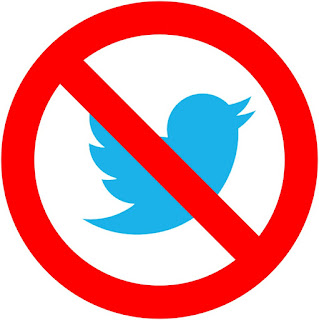To Tweet or Not to Tweet? Some thoughts from the AEA conference.
 |
| No tweets! |
Someone made the observation that it was mostly early career researchers that were using the No tweet. This may seem surprising at first, as us 'early career' people are supposed to be all over this social media thing, right? I've seen some discussions on Twitter that really don't see the problem with sharing someone else's work in a public forum; science should be open, and open means sharing. I think there is a tension between being open with data, and the real worry about career impacts (and really, it is ok to care about your career - we're all doing science/archaeology because we love it, but we also need jobs). There is the argument that if you are open, and have your name attached to an idea, then everyone will know that it is yours and you don't have to worry. I think it is more complicated than this, especially if you work in an area that is very competitive and popular. It would be pretty easy for someone to say they came up with an idea independently, and to publish it before you (in an actual journal, which is what counts when it comes to getting jobs).
I noticed one No Tweet paper had a slightly different approach, in that Tweeting was ok, but no pictures of the slides. The presentation used a lot of archive images, and perhaps the speaker didn't have permission for these to be 'shared'? There is also the question of stealing someone's thunder; they are the ones presenting this exciting new research to an audience of peers, but it is the tweeter who is sharing that to a wider audience, and perhaps gaining all the kudos of retweets and shares.
I don't have an answer to this yet. My own tweeting at conferences is much more about my thoughts on a paper rather than trying to tweet the results/data. Now that I have a permanent job, I feel much happier about being fully open about everything, though I would prefer to have a conference talk filmed and shared that way, rather than a disconnected series of tweets.

I was interested to see the 'tweet but no photos' modification to the system appear. I actually designed a similar logo at the same time as the other two but my colleagues decided not to implement it in favour of a simpler in/out policy. I wonder if that was because none of them (at that time) used Twitter.
ReplyDeleteI like the no photos of slides idea, I think it removes a lot of the concerns people might have
DeleteMe too. I was concerned in devising the policy that it should be simple and I still think this was a useful halfway between yes or no. Ultimately, it probably fell down on me being unable to convince my fellow conference organisers as to why this was a good idea. I still have the graphics I created and, since I'm now on the AEA committee, I might suggest again that it's used for future AEA conferences.
DeleteI think you're right to highlight the tension between wanting exposure and fear of results/ideas being stolen. I also think that this might be more of a problem in the traditional 'hard sciences' than it is in archaeology. Then again, perhaps that's just me being naive.
I don't do a lot of live Tweeting but when I have, like you, it's tended to be my thoughts rather reporting. As far as that's possible in 140 characters!